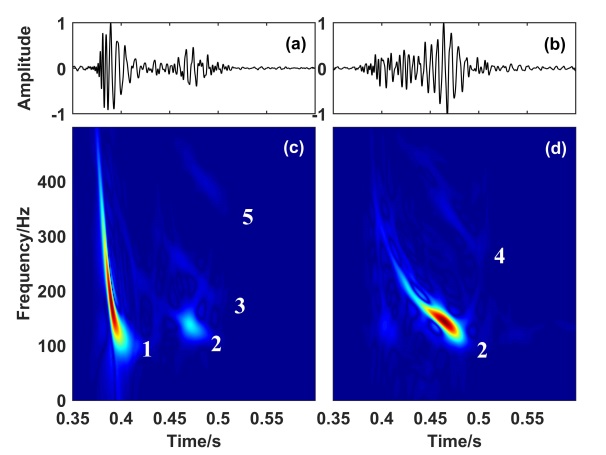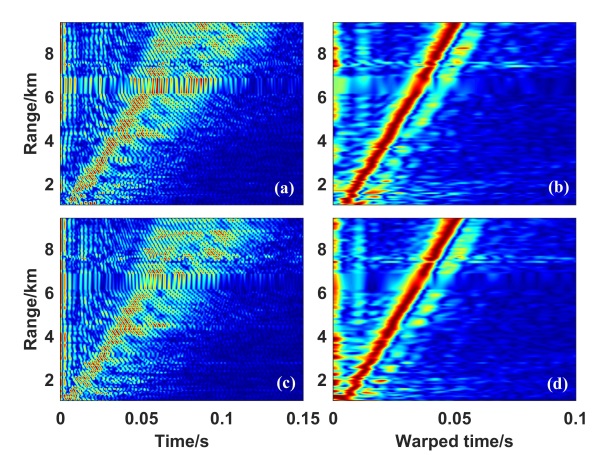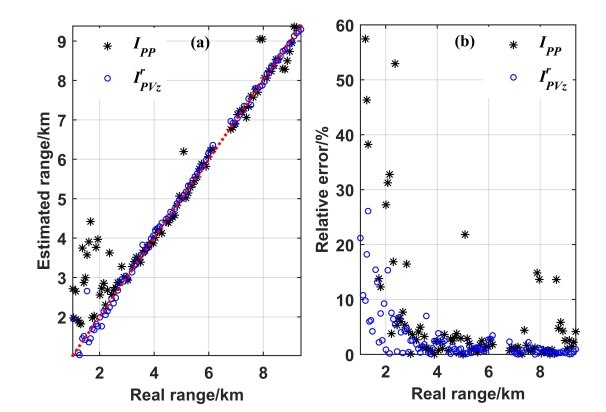In a low-frequency shallow water waveguide, the acoustic field is always dominated by a set of normal modes that propagate dispersively. In the field, each frequency component travels with different group speed (as shown in Figure 1). For the raw received signal, it has been demonstrated that normal mode filtering could be achieved by combining traditional time-frequency analysis and warping transform. However, the warping transform is confined to impulsive sources. When it comes to non-impulsive sources, deconvolving the source phase influence beforehand is required.

Figure 1. The received signals and their time-frequency representations: (a) Normalized waveform of the received pressure, (b) normalized waveform of the received vertical velocity, (c) spectrogram of the received pressure, (d) spectrogram of the received vertical velocity. (Image by IOA)
In order to eliminate the source phase restriction and avoid the procedure of deleting modal autocorrelation component for warping the signal autocorrelation function, researchers from the Institute of Acoustics (IOA) of the Chinese Academy of Sciences proposed a passive source ranging method based on the frequency warping transform of the vertical intensity flux in shallow water. The real part of the transformed flux only contains modal cross-correlation component and the source phase is deleted due to the cross-correlation processing of the pressure and vertical velocity.
The study was published online in Chinese Physics B.
The phase of modal cross-correlation function in frequency domain was expressed by the waveguide invariant. Based on the expression of the phase, the cross-correlation components of two different modes in the vertical intensity flux were warped into separable impulsive sequences using a waveguide-invariant-based frequency warping operator (as shown in Figure 2).

Figure 2. Waterfall plot of the unwarped and warped vertical intensity flux at different ranges: (a) unwarped real part, (b) warped real part, (c) unwarped imaginary part, (d) warped imaginary part. (Image by IOA)
The time delays of the sequences were subsequently used for source ranging with a guide source providing the reference time. Comparing with warping the pressure autocorrelation function, there was no need to delete the modal autocorrelation component for warping the vertical intensity flux, especially for its real part. Besides, the source ranging result based on the time delay of the warped vertical intensity flux was much better for closer ranges (as shown in Figure 3).

Figure 3. Source ranging results: (a) estimated range vs. real range, (b) relative error. (Image by IOA)
Mode number identification is usually needed before source ranging in order to make sure that the same combination of two modes is used for the guide source and the target source, which is the key point of researchers’ future work.
The study was supported by the Frontier Science Research Project of Chinese Academy of Sciences (No. QYZDY-SSW-SLH005).
Reference:
QI Yubo, ZHOU Shihong, YU Mengxiao, DU Shuyuan, SUN Mei, ZHANG Renhe. A passive source ranging method based on the frequency warping transform of the vertical intensity flux in shallow water. Chinese Physics B, 2019, 28(5):054302. DOI: 10.1088/1674-1056/28/5/054302.
Contact:
ZHOU Wenjia
Institute of Acoustics, Chinese Academy of Sciences, 100190 Beijing, China
E-mail: media@mail.ioa.ac.cn


